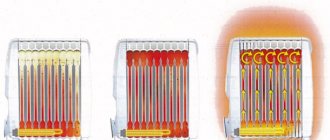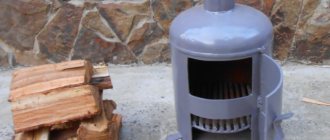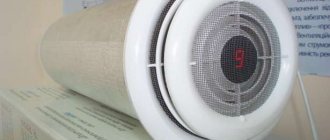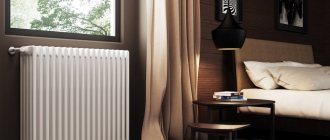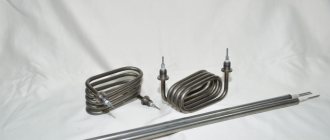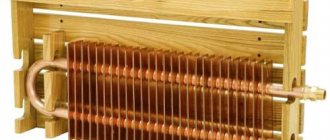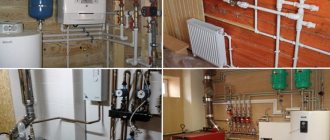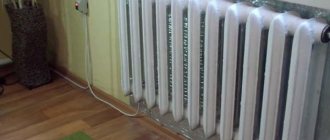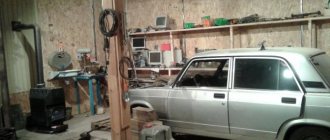Those who want to make a heater with their own hands are not decreasing: the prices for factory-made autonomous heating devices are not encouraging, and their declared characteristics often turn out to be overpriced compared to the real ones. It is useless to make claims: y - the efficiency of heating a room strongly depends on its thermal properties. Cases where compensation for the consequences of an accident that occurred due to the fault of their product are also rare. True, although it is not prohibited by law to make household heaters yourself, trouble caused by a homemade product will be a serious aggravating circumstance for its manufacturer and owner. Therefore, this article further describes how to correctly design and manufacture safe household heaters of several systems, which are not inferior in thermal efficiency to the best industrial designs.
Constructions
Amateur craftsmen build heaters that are often very intricate in design, see photo in Fig. Sometimes they are done carefully. But the vast majority of homemade heating devices described in RuNet have one thing in common: the high degree of danger they create, harmoniously combined with a complete discrepancy between the expected technical characteristics and the actual ones. First of all, this relates to reliability, durability and transportability.
homemade heaters
Make a heater for your home. premises or a camping autonomous one for summer cottages, tourism and fishing, the following systems are possible (from left to right in the figure):
- With direct air heating using natural convection - an electric fireplace.
- With forced blowing of the heater - fan heater.
- With indirect air heating, natural convection or forced air flow - oil or water-air heater.
- In the form of a surface emitting thermal (infrared, IR) rays - a thermal panel.
- Fiery autonomous.
The latter differs from a stove, stove or hot water boiler in that most often it does not have a built-in burner/furnace, but uses waste heat from heating and cooking appliances. However, the line here is very blurred: gas heaters with a built-in burner are commercially available and can be made independently. Many of them can be used to cook or reheat food. Here, at the end, a flame heater will also be described, which is not wood-based, not liquid fuel, not gas-based, and certainly not a stove. And the others are considered in descending order of their degree of safety and reliability. Which, nevertheless, with proper execution and in the “worst” samples, fully comply with the requirements for household autonomous heating devices.
Safety precautions
Making a heater is not difficult. It is much more difficult to save a building from fire when using homemade devices. Compliance with fire safety regulations is an integral part of any work with thermal heaters.
You should always remember:
- Do not use faulty electrical appliances.
- Such devices should not be left unattended or alone with small children.
- Caring parents always try to make sure that dangerous parts of heaters are inaccessible to children.
- If a fire occurs, immediately turn off the power supply to the device and then extinguish it. Immediately call the Ministry of Emergency Situations.
As a safety precaution, wise parents always teach their children how to properly handle thermal heaters and explain what they can and cannot do and why. By following fire safety rules and using only proven and reliable heaters, those living in the house will enjoy warmth and comfort for many years.
Algorithm for making a heater yourself;
Long gone are the days when the only way to heat a private home was a wood stove. Modern technologies and materials make it possible to choose a heating method from a variety of existing ones, but experts unanimously say that in the future, electric heating of a private home will be a priority. Everyone knows that mineral reserves are far from endless and the time will come when we will have to completely abandon gas and switch to a cleaner energy source - electricity.
Electric heating systems have a lot of undeniable advantages, and often it may simply be the only heating method available.
It is very important to think through the electric heating project at the stage of building a house, since in the future, installing equipment in a ready-made room may lead to the need for remodeling, and, as a result, to additional costs. Accurate thermal calculations must be made taking into account SNiP standards. Failure to comply with these requirements will result in increased energy costs.
Thermal panel
This is quite complex and labor-intensive, but the safest and most effective type of household electric heater: a double-sided thermal panel for 400 W in a 12 sq. m room. m in a concrete house heats from +15 to +18 degrees. The required power of the electric fireplace in this case is 1200-1300 W. The cost of making a thermal panel yourself is small. Thermal panels work in the so-called. far (more distant from the red region of the visible spectrum) or long-wave IR, so the heat is soft, not burning. Due to the relatively weak heating of the heat-emitting elements, if they are made correctly (see below), the operational wear of thermal panels is practically absent, and their durability and reliability are limited by unforeseen external influences.
The heat-emitting element (emitter) of a thermal panel consists of a thin flat conductor made of a material with high electrical resistivity, sandwiched between 2 plates - dielectric plates transparent to IR. Thermal panel heaters are made using thin-film technology, and the covers are made from a special plastic composite. Both are unavailable at home, so many hobbyists are trying to make heat emitters based on a carbon coating sandwiched between 2 glasses (item 1 in the figure below); ordinary silicate glass is almost transparent to IR.
This technical solution is a typical surrogate, unreliable and short-lived. The conductive film is obtained either from candle soot or by spreading an epoxy compound filled with ground graphite or electrical carbon onto the glass. The main drawback of both methods is the uneven film thickness. Carbon in the amorphous (coal) or graphitic allotropic modification is a semiconductor with high intrinsic conductivity for this class of substances. The effects characteristic of semiconductors appear in it weakly, almost imperceptibly. But with increasing temperature of the conductive layer, the electrical resistivity of the carbon film does not increase linearly, like that of metals. The consequence is that thin areas heat up more and burn out. The current density in the thicker ones increases, they heat up, they also burn out, and soon the entire film burns out. This is the so-called. avalanche burnout.
In addition, the soot film is very unstable and quickly crumbles on its own. To obtain the required heater power, up to 2 volumes of carbon filler must be added to the epoxy glue. In fact, up to 3 is possible, and if you add 5-10% by volume of a plasticizer - dibutyl phthalate - to the resin before adding the hardener, then up to 5 volumes of filler. But the ready-to-use (not hardened) compound turns out to be thick and viscous, like plasticine or fatty clay, and it is unrealistic to apply it with a thin film - epoxy sticks to everything in the world except paraffin hydrocarbons and fluoroplastic. You can make a spatula out of the latter, but the compound behind it will stretch out in clumps and lumps.
Finally, graphite and coal dust are very harmful to health (have you heard about silicosis in miners?) and extremely dirty substances. It is impossible to remove or wash away their traces; soiled things have to be thrown away, they stain others. Anyone who has ever dealt with graphite lubricant (this is the same finely crushed graphite) - as they say, I will live, I will not forget. That is, homemade emitters for thermal panels need to be made in some other way. Fortunately, calculations show that the “good old”, proven over many decades and inexpensive nichrome wire is suitable for this.
Calculation
Through 3-mm window glass, approx. 8.5 W/sq. dm IR. From the “pie” of the thermal panel emitter, 17 W will go in both directions. Let's set the dimensions of the emitter to 10x7 cm (0.7 sq. dm); such pieces can be cut from culls and cutting waste in almost unlimited quantities. Then one emitter will give us a room of 11.9 W.
Let's take the heater power to be 500 W (see above). Then you will need 500/11.9 = 42.01 or 42 emitters. Structurally, the panel will consist of a matrix of 6x7 emitters with dimensions without frames of 600x490 mm. Let's put it on a frame up to 750x550 mm - ergonomically it works, it's quite compact.
The current consumed from the network is 500 W/220 V = 2.27 A. The electrical resistance of the entire heater is 220 V/2.27 A = 96.97 or 97 Ohms (Ohm’s law). The resistance of one emitter is 97 Ohm/42 = 2.31 Ohm. The resistivity of nichrome is almost exactly 1.0 (Ohm * sq. mm)/m, but what cross-section and length of wire is needed for one emitter? Will the nichrome “snake” (item 2 in the figure) fit between 10x7 cm glass?
Design and drawings of a homemade infrared panel heater
Current density in open, i.e. in contact with air, nichrome electric spirals - 12-18 A/sq. mm. They glow from dark to light red (600-800 degrees Celsius). Let's take 700 degrees at a current density of 16 A/sq. mm. Under the condition of free IR radiation, the temperature of nichrome depends on the current density approximately by the square root. Let's reduce it by half, to 8 A/sq. mm, we get the operating temperature of nichrome at 700/(2^2) = 175 degrees, safe for silicate glass. The temperature of the outer surface of the emitter (without taking into account heat removal due to convection) will not exceed 70 degrees with an outer surface of 20 degrees - it is suitable both for heat transfer by “soft” IR and for safety if you cover the emitting surfaces with a protective mesh (see below).
A rated operating current of 2.27 A will give a nichrome cross section of 2.27/8 = 0.28375 sq. mm. Using the school formula for the area of a circle, we find the diameter of the wire - 0.601 or 0.6 mm. Let us take it with a margin of 0.7 mm, then the heater power will be 460 W, because it depends on its operating current squared. 460 W is enough for heating; 400 W would be enough, and the durability of the device will increase several times.
1 m of nichrome wire with a diameter of 0.7 mm has a resistance of 2.041 Ohms (0.7 squared = 0.49; 1/0.49 = 2.0408...). To obtain a resistance of one emitter of 2.31 Ohms, you will need 2.31/2.041 = 1.132... or 1.13 m of wire. Let's take the width of the nichrome “snake” to be 5 cm (1 cm of margin at the edges). Add 2.5 mm per turn of 1 mm nails (see below), for a total of 5.25 cm per snake branch. The branches will be needed 113 cm/5.25 cm = 21.52..., let's take 21.5 branches. Their total width is 22x0.07 cm (wire diameter) = 1.54 cm. Let's take the length of the snake to be 8 cm (1 cm of margin from the short edges), then the wire laying coefficient is 1.54/8 = 0.1925. In the lousiest Chinese low-power power transformers it is approx. 0.25, i.e. We have plenty of space for the bends and gaps between the branches of the snake. Phew, the fundamental issues have been resolved, we can move on to R&D (experimental design work) and technical design.
OCD
The thermal conductivity and transparency of IR silicate glass vary greatly from brand to brand and from batch to batch. Therefore, first you will need to make 1 (one) emitter, see below, and test it. Depending on their results, you may have to change the diameter of the wire, so do not buy a lot of nichrome at once. In this case, the rated current and power of the heater will change:
- Wire 0.5 mm – 1.6 A, 350 W.
- Wire 0.6 mm - 1.9 A, 420 W.
- Wire 0.7 mm - 2.27 A, 500 W.
- Wire 0.8 mm - 2.4 A, 530 W.
- Wire 0.9 mm - 2.6 A, 570 W.
Note: for those who are literate in electricity, the rated current, as you can see, does not change according to the square of the wire diameter. Why? On the one hand, thin wires have a relatively large radiating surface. On the other hand, with a thick wire, the permissible IR power transmitted by the glass cannot be exceeded.
For testing, the finished sample is installed vertically, supported by something non-flammable and heat-resistant, on a fireproof surface. Then the rated current is supplied to it from an regulated power supply (PS) of 3 A or more or LATP. In the latter case, the sample cannot be left unattended during the entire test! The current is controlled by a digital tester, the probes of which must be tightly compressed with the current-carrying wires using a screw with a nut and washers. If the prototype is powered by LATR, the tester must measure the AC current (limit AC 3A or AC 5A).
First of all, you need to check how the glass behaves. If it overheats and cracks within 20-30 minutes, then the entire batch may be unusable. For example, dust and dirt become embedded in used glass over time. Cutting them is sheer agony and the death of a diamond glass cutter. And such glass cracks at much lower heat than new glass of the same type.
Then, after 1-1.5 hours, the strength of the IR radiation is checked. The temperature of the glass is not an indicator here, because... The main part of the IR is emitted by nichrome. Since you most likely will not have a photometer with an IR filter, you will have to check it with your palms: they are held parallel to the emitting surfaces at a distance of approx. 15 cm from them for at least 3 minutes. Then, for 5-10 minutes, you should feel even, soft warmth. If the IR from the emitter begins to burn the skin immediately, reduce the diameter of the nichrome. If after 15-20 minutes you don’t feel a slight burning sensation (as in the sun in the middle of summer), you need to take thicker nichrome.
How to bend a snake
The design of the emitter of a homemade panel heater is shown in pos. 2 fig. higher; The nichrome snake is shown conditionally. Glass plates cut to size are cleaned of dirt and washed with a brush in water with the addition of any dishwashing detergent, then also washed with a brush under running clean water. “Ears” - contact lamellas measuring 25x50 mm made of copper foil - are glued to one of the covers with epoxy glue or instant cyanoacrylate (superglue). The overlap of the “ear” on the lining is 5 mm; 20 mm sticks out. To prevent the lamella from falling off before the glue has set, place something 3 mm thick (the thickness of the lining glass) under it.
Next you need to form the snake itself from nichrome wire. This is done on a mandrel template, the diagram of which is given in pos. 3, and a detailed drawing is in Fig. Here. The “tails” for annealing the snake (see below) should be given at least 5 cm. The bitten ends of the nails are sanded to roundness on an emery stone, otherwise it will be impossible to remove the finished snake without crushing it.
Drawing of a template for forming a flat nichrome heating element
Nichrome is quite elastic, so the wire wound on the template must be annealed so that the snake holds its shape. This should be done in semi-darkness or low light. The snake is supplied with a voltage of 5-6 V from a power supply of at least 3 A (this is why a fireproof lining is needed on a tree). When the nichrome glows cherry, turn off the current, allow the thread to cool completely, and repeat this procedure 3-4 times.
The next step is to press the snake with your fingers through the plywood strip placed on it and carefully unwind the tails wound on 2 mm nails. Each tail is straightened and shaped: a quarter of a turn remains on a 2-mm nail, and the rest is cut flush with the edge of the template. The remainder of the “tail” of 5 mm is cleaned with a sharp knife.
Now the snake needs to be removed from the mandrel without damaging it, and secured to the substrate, ensuring reliable electrical contact of the leads with the lamellas. Remove with a pair of knives: their blades are slipped from the outside under the bends of the branches on 1-mm nails, carefully pry up and lift the crimped thread of the heater. Then the snake is placed on the substrate and the leads are bent a little, if necessary, so that they lie approx. in the middle of the slats.
Nichrome cannot be soldered with metal solders with inactive flux, and the remaining active flux can corrode the contact over time. Therefore, nichrome is “soldered” to copper, so-called. liquid solder - conductive paste; It is sold in radio stores. A drop of liquid solder is squeezed onto the contact of the stripped nichrome with copper and pressed with a finger through a piece of plastic film so that the paste does not stick out upward from the wire. You can immediately press it down with some flat weight instead of your finger. Remove the weight and film after the paste has hardened, from an hour to a day (the time is indicated on the tube).
The “solder” has frozen – it’s time to assemble the emitter. Along the middle we squeeze a thin, no thicker than 1.5 mm, “sausage” of ordinary construction silicone sealant onto the snake, this will prevent the wire bends from slipping and closing. After this, we squeeze out the same sealant with a thicker roller, 3-4 mm, along the contour of the substrate, retreating from the edge of approx. by 5 mm. We apply a cover glass and very carefully so that it does not slide to the side and pull the snake along with it, press down until it fits tightly, and set the emitter aside to dry.
The drying rate of silicone is 2 mm per day, but after 3-4 days, as it may seem, it is still impossible to take the emitter into work further; you need to let the inner roller that fixes the bends dry. You will need approx. a week. If many emitters are made for a working heater, they can be dried in a stack. The bottom layer is laid out on plastic film, and covered with it on top. Elements following. layers are laid across the underlying ones, etc., separating the layers with film. The stack, for guarantee, takes 2 weeks to dry. After drying, the protruding excess silicone is cut off with a safety razor blade or a sharp mounting knife. Silicone deposits must also be completely removed from the contact lamellas, see below!
Installation
While the emitters are drying, we make 2 identical frames from slats of hard wood (oak, beech, hornbeam) (item 4 in the figure with the diagram of the panel heater). The connections are made by cutting into half the wood and fastened with small self-tapping screws. MFD, plywood and wood materials with synthetic binders (chipboard, OSB) are not suitable, because prolonged heating, even if not strong, is strictly contraindicated for them. If you have the opportunity to cut frame parts from textolite or fiberglass, that’s generally great, but ebonite, bakelite, textolite, carbolite and thermoplastic plastics are not suitable. Before assembly, wooden parts are impregnated twice with a water-polymer emulsion or water-based acrylic varnish diluted in half.
Ready-made emitters are placed in one of the frames (item 5). The overlapping lamellas are electrically connected by drops of liquid solder, as are the jumpers on the sidewalls, forming a series connection of all emitters. It is better to solder the supply wires (from 0.75 sq. mm) with ordinary low-melting solder (for example, POS-61) with inactive flux paste (composition: rosin, ethyl alcohol, lanolin, see on the bottle or tube). Soldering iron - 60-80 W, but you need to solder quickly so that the emitter does not come unglued.
The next step at this stage is to apply a second frame and mark on it where the supply wires are located; grooves will need to be cut for them. After this, we assemble the frame with the emitters using small screws, pos. 6. Take a closer look at the location of the fastening points: they should not fall on live parts, otherwise the fastening heads will be energized! Also, in order to prevent accidental contact with the edges of the lamellas, all ends of the panel are covered with non-flammable plastic with a thickness of 1 mm, for example. PVC filled with chalk from cable channels (ducts for wiring). For the same purpose, and for greater structural strength, silicone sealant is applied to all joints of the glass and frame parts.
The final steps are firstly the installation of legs with a height of 100 mm. A sketch of the wooden leg of a panel heater is given in pos. 7. The second is to apply a protective steel mesh made of thin wire with a mesh size of 3-5 mm to the sidewalls of the panel. Third, the cable entry is designed with a plastic box: it houses contact terminals and a light indicator. Possibly a thyristor voltage regulator and a protective thermal relay. That's it, you can turn it on and warm up.
Thermal painting
If the power of the described thermal panel does not exceed 350 W, a picture heater can be made from it. To do this, foil insulation is applied to the back side, the same one that is used for thermal insulation. Its foil side should be facing the panel, and the porous plastic side should be facing out. The front side of the heater is decorated with a fragment of photo wallpaper on plastic; thin plastic is not such an obstacle for IR. In order for the picture-heater to warm better, you need to hang it on the wall at an angle of approx. 20 degrees.
What about foil?
As you can see, a homemade panel heater is quite labor-intensive. Is it possible to simplify the work by using, say, aluminum foil instead of nichrome? The thickness of the baking sleeve foil is approx. 0.1 mm, seems to be a thin film. No, the point here is not the thickness of the film, but the resistivity of its material. For aluminum it is low, 0.028 (Ohm * sq. mm)/m. Without giving detailed (and very boring) calculations, we will indicate their result: the area of a thermal panel with a power of 500 W on an aluminum film 0.1 mm thick turns out to be almost 4 square meters. m. Still, the film turned out to be a bit thick.
Idea N1: Making a local mini-heater
For this design, you will need two rectangular pieces of glass, metal foil, a paraffin or stearin candle, a wooden block (or a block of other dielectric material), an electrical cord with a plug, and sheet metal for contacts.
The manufacturing procedure for such a mini heater is as follows:
- Take two identical pieces of rectangular glass, in this example the dimensions are 4x6 cm, but this is not critical, you can take a different ratio, the main thing is that the area is about 25 cm2. Clean and degrease their surface.
- Using a lit candle, carefully apply a layer of soot to one surface of the glass. Make sure that the carbon black is evenly coated and distributed, as it will act as a conductive material.
Figure 1: elements for making a heater - Using cotton wool or an ear stick, clean the edge of the smoked glass, approximately 5 mm.
- Cut a piece of foil the same width as the soot-covered glass surface. In length it should protrude 3–4 cm beyond the edge of the glass. Place the foil on the glass.
- Coat the edge of the glass with sealant and align the two halves together with the foil in between.
Rice. 2: Combine two glasses
Fold the edges of the foil under the glass to one side.
- Attach metal contacts to a wooden block and solder the ends of the electrical wires with a plug to them. Place the glass on the block - the heater is ready.
Rice. 3: Fix the contacts on a wooden block
It should be noted that the maximum temperature of such a heater should be about 40ºC. Naturally, you won’t be able to heat a house, cottage, or garage with such a homemade heater; it is suitable for heating tents, a work area in front of a workbench, or other space directly in front of the work surface. If the device gets too hot, you will need to reduce the resistance of the conductive elements; for this you can use thicker foil or increase the thickness of the soot.
heating elements
For heaters: types you will have to buy heating elements: 220 V electrical appliances with open heaters are extremely dangerous. Here, pardon the expression, you need to think first of all about your own skin and property, whether there is a formal ban or not. It’s easier with 12-volt devices: according to statistics, the degree of danger decreases in proportion to the square of the supply voltage ratio.
If you already have an electric fireplace, but it doesn’t heat well, it makes sense to replace a simple air heating element with a smooth surface (pos. 1 in the figure) with a finned one, pos. 2. The nature of convection will then change significantly (see below) and heating will improve when the power of the finned heating element is 80-85% of the smooth one.
Types of heating elements
A cartridge heating element in a stainless steel housing (item 3) can heat both water and oil in a tank made of any structural material. If you buy one, be sure to check that the kit includes gaskets made of oil-heat-gasoline-resistant rubber or silicone.
A copper water heating element for a boiler is equipped with a tube for a temperature sensor and a magnesium protector, pos. 4, which is good. But they can only heat water and only in a stainless steel or enameled tank. The heat capacity of oil is much less than that of water, and the body of a copper heating element in oil will soon burn out. The consequences are severe and fatal. If the tank is made of aluminum or ordinary structural steel, then electrocorrosion due to the presence of a contact potential difference between the metals will very quickly eat away the protector, and then eat through the body of the heating element.
T. called. dry heating elements (item 5), like cartridge ones, are capable of heating both oil and water without additional protective measures. In addition, their heating element can be changed without opening the tank and without draining the liquid from there. There is only one drawback - they are very expensive.
Options for a homemade heating element
Before you start making a homemade fan heater, it is important to choose the right heating element for your device. Let's look at which options are suitable for these purposes.
The following can be used as such a heater:
- metal spiral;
- heating element;
- ceramic device.
You can make a spiral coiled from wire yourself without any problems. This limits the advantages of metal spirals as heaters. When the device operates for a long time, there is too little moisture and oxygen in the surrounding air.
Therefore, the room will have to be ventilated frequently, well ventilated, and also take care of air humidification.
The heating element is a metal pipe containing sand inside, which accumulates heat well and then gradually releases it to the air flow.
Heating elements do not dry the air and do not require oxygen, so they are much safer than coils. The heating element for the fan heater can be removed from an old household appliance, for example, from an electric stove.
We recommend looking at more information about the types of heating elements for heating and the features of choosing the appropriate option in this article.
A heating element - one of the heater options for a fan heater - can look different. It is considered an effective and safe heating element option
Ceramic heaters are complex and expensive elements, but extremely safe and effective. They are a complex of plates with an uneven surface, similar to a honeycomb.
Such elements do not heat up too much; the effect of their influence is achieved due to the large area of contact of the heaters with the air.
The likelihood of getting burned on a ceramic heater is much lower than when using a metal coil. But in home-made devices, it is spirals that are most often used, since they are simple and affordable.
Fireplace
Diagram of an electric fireplace with an air heating element and a double convection circuit
You can improve an ordinary electric fireplace, or make your own efficient one based on a purchased heating element, using an additional casing that creates a secondary convection circuit. From a conventional electric fireplace, firstly, the air flows upward in a rather hot but weak stream. It quickly reaches the ceiling and through it warms more of the neighbors' floors, attic or roof than the owner's room. Secondly, the IR coming down from the heating element in the same way warms the neighbors below, the subfloor or basement.
In the design shown in Fig. on the right, downward IR is reflected into the outer casing and heats the air in it. The thrust is further enhanced by the suction of hot air from the inner casing, which is less heated from the outer casing at the narrowing of the latter. As a result, the air from an electric fireplace with a double convection circuit comes out in a wide, moderately heated stream, spreads to the sides without reaching the ceiling, and effectively heats the room.
DIY fan heater made from trash (video)
In the video you will clearly see how a fan heater is made from various elements that may remain from components of household appliances that are no longer working.
For the fan heater model in question you will need:
- Cover with cooler from the power supply;
- Broken hair dryer;
- Plastic grille for ventilation;
- Iron cord with plug;
- Textolite;
- Pieces of plywood.
Step by step guide:
- Installing the heating element
. A frame is made from narrow strips of textolite, and a spiral, which was removed from a hair dryer, is wound onto it in a zigzag. Holes are prepared in the textolite structure and wire is inserted into them. A spiral is attached to it so that it does not touch the frame material. As a result, the spiral plays the role of a large variable resistor. - Fan connection
. On the created frame with a spiral, using a voltage meter, find the area with the lowest alternating voltage. You need to solder the diode to the plus, and connect the wiring from the cooler to the minus. This circuit completely replaces the power supply. - Execution of the body
. The side walls are screwed to the cooler lid, and a grille is inserted into the remaining empty wall and fixed with glue from a hot-melt gun.
The resulting device consumes little electricity, operates silently and can easily heat certain places in the room. For example, if your feet get cold while working in the workshop, you can install a fan heater under the table and it will warm them.
If you need to ensure high-quality heating of the room before turning on the central heating or after its completion, during a period when there are particularly cold days, then you can’t imagine a better homemade fan heater. It is compact, economical and productive, it can be created from available materials
A thermal curtain is a type of heating of large premises in terms of area and volume, mainly for industrial and commercial purposes.
The heat curtain device is a heat exchanger with an increased heat transfer area due to the use of aluminum lamellas applied to the circulation copper tubes of the heat exchanger itself. A large-volume fan sucks air from the room and throws it back into the room, passing it through a heat exchanger through which water circulates.
The hydraulic connection allows the installation of water heat curtains directly on the walls, as close as possible to the doorway and allows mounting in three positions:
- vertically,
- horizontally with connection pipes from below and
- horizontally – pipes on top.
This allows you to optimally direct warm air down or to the side, cutting off cold air flows from the street, creating an air barrier.
Oil and water
The effect described above is also produced by oil and water-air heaters, which is why they are popular. Industrially produced oil heaters are made hermetically sealed with a permanent filling, but it is in no case recommended to repeat them yourself. Without an accurate calculation of the volume of the housing, internal convection in it and the degree of oil filling, a rupture of the housing, an electrical failure, oil spillage and fire are possible. Underfilling is just as dangerous as overfilling: in the latter case, the oil simply tears the housing under pressure when heated, and in the former, it first boils. If you make the housing of a deliberately larger volume, then the heater will heat disproportionately weakly compared to the electricity consumption.
In amateur conditions, it is possible to build an open-type oil or water-air heater with an expansion tank. The diagram of its device is shown in Fig. Once upon a time they made quite a lot of these, for garages. The air from the radiator is slightly heated, the temperature difference between inside and outside is kept minimal, which is why heat loss is reduced. But with the advent of panel heaters, oil-based homemade products are disappearing: thermal panels are better in all respects and are completely safe.
Oil heater device with expansion tank
If you still decide to make your own oil heater, keep in mind that it must be reliably grounded, and you only need to fill it with very expensive transformer oil. Any liquid oil gradually bituminizes. Increasing temperature accelerates this process. Motor oils are designed to allow oil to circulate among moving parts due to vibration. Bituminous particles in it form a suspension that only pollutes the oil, which is why it has to be changed from time to time. In the heater, nothing will prevent them from depositing carbon deposits on the heating element and in the tubes, causing the heating element to overheat. If it bursts, the consequences of oil heater accidents are almost always very serious. Transformer oil is expensive because the bituminous particles in it do not settle into soot. There are few sources of raw materials for mineral transformer oil in the world, and the cost of synthetic oil is high.
Disadvantages of work
The main disadvantage of electric heating is the high energy consumption. In some areas, energy prices are quite high, so this method may simply not be profitable.
The second disadvantage is energy dependence. If the electricity is turned off for any reason, heating the room will become impossible.
The third disadvantage can be considered the unstable voltage in the power grid, especially in rural areas. Purchasing your own generator eliminates this problem, but significantly increases financial costs.
Fiery
Powerful gas heaters for large rooms with catalytic afterburning are expensive, but record-breakingly economical and efficient. It is impossible to reproduce them under amateur conditions: you need a micro-perforated ceramic plate with platinum coating in the pores and a special burner made of parts made with precision precision. At retail, one or the other will cost more than a new heater with a warranty.
Gas mini camping heaters
Tourists, hunters and fishermen have long come up with low-power afterburner heaters in the form of an attachment to a camp stove. These are also produced on an industrial scale, pos. 1 in Fig. Their efficiency is not so great, but it’s enough to heat the tent until lights out in sleeping bags. The design of the afterburner is quite complex (item 2), which is why factory tent heaters are not cheap. Fans also make a lot of these, from cans or, for example. from automobile oil filters. In this case, the heater can operate both from a gas flame and from a candle, see video:
Video: Portable oil filter heaters
With the advent of heat-resistant and heat-resistant steels in widespread use, lovers of being outdoors are increasingly giving preference to gas camping heaters with afterburning on a grid, pos. 3 and 4 - they are more economical and heat better. And again, amateur creativity combined both options into a combined type mini-heater, pos. 5., capable of working from both a gas burner and a candle.
Drawing of a mini-heater made from scrap materials for a summer residence
A drawing of a homemade mini-heater with afterburning is shown in Fig. on right. If it is used occasionally or temporarily, it can be made entirely from tin cans. For an enlarged version for the garden, cans of tomato paste, etc. will be used. Replacing the perforated mesh cover significantly reduces warm-up time and fuel consumption. A larger and very durable version can be assembled from car wheels, see next. video clip. This is already considered a stove, because... You can cook on it.
Video: heater-stove made from a wheel rim
Directional heat gun
A heat gun of our own production has enough power to easily heat a garage, utility room or office in the house.
For assembly you will need:
- a piece of plywood 16 mm thick;
- fan (duct);
- temperature and speed controllers;
- PBEC heating element (2.2 kW);
- fasteners (clamp, bracket, studs, nuts, washers);
- wheels.
We cut out a rectangle of approximately 47 cm x 67 cm from plywood, sand the rough edges and corners.
The plywood base was not chosen in vain: it is light, flat, and most importantly, it does not conduct electric current, which is important in the event of force majeure circumstances
We connect two central parts with a coupling - the fan and the heating element. We fix the resulting structure on a plywood base using a bracket and a plumbing clamp.
We select fasteners in such a way that they firmly fix the elements of the device and do not cause them harm. For example, self-tapping screws are perfect - they do not destroy plywood
Self-tapping screws (16 mm) are suitable for fastening. We install a temperature sensor (for example, TG-K 330), which is necessary to control the temperature, next to it there are two more devices - for adjusting the speed and temperature.
When connecting the parts of the fan heater to each other, do not forget about the safety of the device: the connection points of wires and cables must be insulated
Pulsar 3.6 is suitable as a thermal regulator. After installing all the necessary devices and parts, we connect them according to the diagram.
Device control circuits can be found in specialized literature, instructions for devices such as an electric fan, or on specialized websites
For ease of use, we screw wheels to the plywood base.
Small rollers screwed on the bottom side make the homemade fan heater more convenient to move around the room, especially if it is heavy.
Well, that’s all - the homemade heat gun is ready.
Try to place the device parts in such a way that, if necessary, it is easy to disassemble each of them and replace failed elements
Like any homemade fan heater, this device has disadvantages. For example, when the device is stopped, the voltage on the heating element remains, and this is quite dangerous, since overheating occurs and an emergency situation is possible. The situation can be corrected by installing a relay to timely turn off the power supply to the temperature controller. Another disadvantage is inadequate heating of the room, but this is a disadvantage of almost all stationary fan heaters.
From a candle
A candle, by the way, is a fairly strong source of heat. For a long time, this property was considered a hindrance: in the old days, at balls, ladies and gentlemen would sweat, makeup would run, and powder would clump together. How they even turned cupids after that, without hot running water and a shower, is difficult for a modern person to understand.
Home mini heater from a candle
The heat from a candle in a cold room is wasted for the same reason that a single-circuit convection heater does not heat well: hot exhaust gases rise up too quickly and cool, producing soot. Meanwhile, making them burn out and give heat is easier than a gas flame, see fig. In this system, a 3-circuit afterburner is assembled from ceramic flower pots; baked clay is a good IR emitter. A candle heater is intended for local heating, say, so as not to tremble while sitting at the computer, but just one candle provides a surprising amount of heat. When using it, you only need to open the window slightly, and when going to bed, be sure to extinguish the candle: it also consumes a lot of oxygen for combustion.
Types of heat fans
Homemade heat fans come in completely different varieties. It depends on the purpose of their use.
Asbestos heater
For example, a structure made of asbestos pipe. To create a heating device, a pipe with a diameter of 15 centimeters and a wall thickness of 10 centimeters is suitable. The body can be half a meter or more, but the most optimal option is 60 centimeters. They use a pipe to wrap it in a spiral, and then install it between two supports.
Heat gun
Sometimes a device is needed to heat a large area. In such cases, our craftsmen can build a heating system called (Heat Gun). This is the largest model. Heating of a large space is guaranteed.
The fan heater is a fairly simple device in design.
Whether the heating device is water-based or not, you can make it yourself, but be careful. Because design safety is the most important rule so that the device does not lead to a fire or various types of injuries.
Choosing an installation location
The correct choice of installation location is the key to success in the enterprise of creating a water fan heater. First of all, you need to figure out how the temperature will be distributed throughout the room. The flow of hot air should not be cut off due to the architectural features of the room.
You should choose an installation location from which the heated air will be distributed as far as possible. It is worth understanding that the fan needs to be taken somewhere to create air flow, so you cannot install the future device close to the wall.
Electric fan heaters
Buying an industrial fan heater of an electric modification would be an advisable solution if it is not possible to install water-based analogues.
If the object requiring heating is not equipped with a heating system, and there is no possibility of connecting to hot water pipes, the installation of electric industrial fan heaters will be optimal, since it can be organized in the shortest possible time and will require a relatively small initial investment. True, in operation, industrial electric fan heaters are somewhat less energy efficient than water ones. Currently, several variations of electric fan heaters are produced that operate from the electrical network. You can buy industrial fan heaters with the following types of electric heating elements:
- Spiral. They belong to the most budget category of fan heaters. But at low cost they have some disadvantages. For example, due to the high degree of heating, the spirals have a drying effect on the interior of the heated room. Industrial spiral-type fan heaters are not used in explosive areas and production workshops, the technological process of which is associated with significant dust formation. Dust falling on an open hot coil burns, which leads to the formation of an unpleasant odor.
- Ceramic. Electric industrial fan heaters with ceramic heating elements are much safer and ergonomic units. Mainly because the temperature of ceramic heaters cannot exceed one hundred degrees during operation, therefore, the likelihood of dust ignition and gas explosion is significantly reduced. The same factor practically eliminates the possibility of drying the air in a heated room. However, the cost of industrial fan heaters with ceramic heaters is higher compared to their spiral counterparts.
Electrical diagram for connecting Volcano VR water fan heaters
ATTENTION! Before connecting the fan heaters, you must turn off the power supply! Cable connections must be made by qualified personnel in accordance with the instructions. Due to the fact that VTS Euroheat has updated its line of VOLCANO VR water fan heaters, and now they all have a three-speed electric motor, in our opinion it is advisable to use the 3 most popular methods of electrical connection of VOLCANO VR fan heaters
The nominal cross-section of the connected wire is 1.5mm2, for example, PVA 3x1.5.
Method No. 1 Direct connection of VOLCANO VR fan heaters to the network
The diagram clearly shows how to connect the VOLCANO VR fan heater directly to the network. Where:
At number 1, we have a 1-phase power supply 220V-50Hz, VOLCANO VR fan heaters are powered from a regular household 220V network, which expands the scope of their application.
Number 2 is the main switch and fuses. Recommended protection: overvoltage (fan heater VOLCANO VR - 4 A), as well as differential protection.
Depending on where to connect the phase supply wire, the choice of rotation speed of the electric motor and its productivity in m3/hour (air flow) will depend:
- Maximum power, connect the phase to connector No. 8;
- Average power, connect the phase to connector No. 7;
- Minimum power, connect the phase to connector No. 6.
Power
Fan heaters from various manufacturers with power from 500 to 2500 W are available on sale. Power is one of the main characteristics of any electrical appliance. It determines how quickly the fan heater heats the room. The more power, the higher the performance. To make the right choice, it is enough to focus on the fact that 100 W are needed to heat one m2. Thus, for a room of 15 m2, a fan heater with a power of 1500 W is sufficient.
The high power of the fan heater allows for good mixing of the air in the room and ensures uniform heating
If you need a main heat source, take devices with a power from 1.8 to 2.5 kW, and if local heating is needed, then you should pay attention to low-power models from 0.5 to 1 kW. They are made in a compact body and are less noisy during operation.
How to install it yourself?
Water thermal curtains, just like air curtains, can be installed in a horizontal or vertical position. Since the curtains are produced in different lengths, installation on the front door or window can be done in a row, using several devices. The connection of this system has a simple diagram consisting of the following elements:
- thermal curtain;
- coarse filter;
- air balloon;
- check valve;
- shut-off valve;
- pump;
- boiler
After drawing up the diagram, the curtains are installed, having previously marked the places for attaching the brackets on which the equipment will be installed. The brackets must be placed evenly, taking into account the size of the doorway. The distance between the top edge of the curtain and the wall or ceiling must be at least 30 cm. This is necessary so that warm air can move freely in the room.
After the brackets are fixed, proceed directly to fastening the thermal curtain, using bolts for this. Since all connecting pipes are located at the same level, it is recommended to additionally install an extension (up to 5 cm). This will make installation work easier in the future. Quick-release connections are installed on the extensions; they are needed for ease of connecting or disconnecting the air curtain.
As for laying the main pipeline, it can be done along the attic floor, maintaining the integrity of the walls. To do this, two holes should be made under each thermal curtain, through which the coolant “return” will be connected to the main pipeline pipes. After installing the shut-off valve, you need to connect the curtains to the system using fittings and polypropylene pipes with a diameter of up to 25 mm.
The installation is completed by filling the system with water and checking the operating pressure, excess air is released through the relief valves. Then you need to check the tightness of all joints and put the system into operation.
The following video provides an overview of the Teplomash water heat curtain KEV-98P4121W.
How to choose a fan heater
- The majority of heat fans are made from plastic. The main requirement for the body is strength. This ensures both durability and safety of use.
- The required power is calculated based on the area of the largest room in which the fan heater is supposed to be installed. It is calculated at the rate of 1000 Watts/10 sq. m.
- You need to choose a mobile or stationary device based on your needs. If heating equipment is required in several rooms, a portable fan will be needed. Stationary models are more powerful and create less noise.
- The noise level also depends on the structure of the fan. The “quiet” type is considered tangential. The axial type of fan does not have this advantage.
- Don't forget about safety. Shutdown functions in case of a fall, cooling in case of overheating, a safe heating element - these parameters will protect users from fire.
- Fan heaters use two types of ceramics: glass and metal. Of these, preference should be given to glass.
- The maximum number of operating modes in modern fans is 3. This number of modes makes the operation of the fan-heater comfortable and economical for users.
Additional functions
More expensive fan heater models have a number of additional functions:
- Splash-proof housing. It allows the device to be used in rooms with high humidity, for example, in the bathroom;
- Timer. This is convenient, because the device automatically turns off at the specified time;
- “Temperature maintenance” function, which allows you to maintain the desired microclimate in the room;
- Function “protection against overheating” and turning off the device when tipping over;
- Convenient display and touch control;
- Built-in humidifier. A special water container is provided for this purpose.
It is important that the device has a thermal relay that turns off the device if it overheats. But even this option does not eliminate the need to constantly monitor the fan heater so that it is not accidentally covered
Of course, in this case the system will work, but the possibility of ignition of flammable materials cannot be ruled out. This is especially true for models with a spiral. Well, don’t forget about the rule that the minimum distance from the heater to any other object should be more than 50 centimeters.
Let's say a few words about the design. Fan heaters are not only a source of heat, but in many cases they are also a stylish device. Manufacturers produce heaters in all sorts of colors, which delight the eye with smooth lines and a variety of shapes.
Popular models
Water fan heaters are made by many manufacturers. of the company Teplomash , which has developed a line of KEV models with a thermal power of 3–120 kW, are in greatest demand among Russian consumers
by Volcano , are in no less demand on the Russian market .
They manufacture various equipment for heating rooms , including water fan heaters. The company supplies several series of fan heaters to Russia with different thermal outputs.
If we compare the models of water fan heaters from these companies, choosing those that are similar in thermal power, we get the following results (see Table 1.)
Table 1. Technical characteristics of water fan heaters
| Water fan heater model | Teplomash KEV 25T3 W2 | Volcano V25 |
| Power | 3.1-7.6 kW | 3-20 kW |
| Installation in premises of: | 31-76 m2 | 80-200 m 2 |
| Air flow | 600-1200 m 3 /h | 4000 3 /h |
| Installation | wall | wall |
| Remote control | There is | There is |

